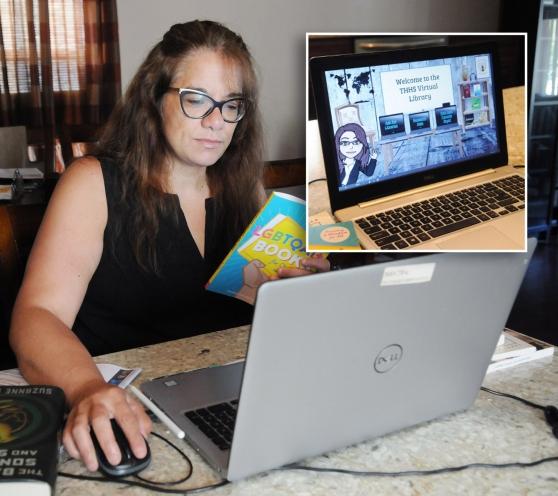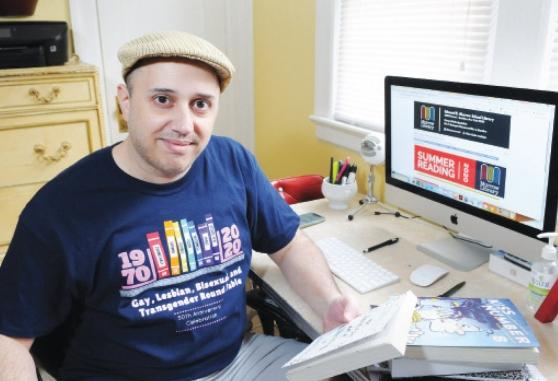
Townsend Harris HS librarian Arlene Laverde works from her home in Queens. Laverde appears in a "bitmoji" on the virtual library homepage (inset).
What's a library without a room full of books? It may sound like a riddle, but it became the reality for school librarians when New York City public school buildings closed in the spring of 2020.
Fortunately, school librarians were eager to embrace the challenges of remote learning.
"My role as a librarian transferred over almost seamlessly into the virtual world," says Esther Keller, a librarian at IS 278 in Marine Park, Brooklyn. "In my building, I'm there to share resources, give support to teachers and collaborate with them. I'm still able to do that remotely."
In the earliest days of remote learning, New York City's community of school librarians mobilized immediately to collaborate on best practices. School librarians played a crucial role in many schools by helping teachers find their footing online.
"Librarians are super tech savvy, and we have been focused on digital access for years. We were ready for this," says Ciro Scardina, a librarian at Edward R. Murrow HS in Midwood, Brooklyn.
Librarians were instrumental in helping teachers and students access and learn to use digital materials and platforms.
"Initially I created video tutorials for teachers and students on accessing and borrowing digital materials from our public library systems. Then I moved on to videos for teachers on how to use digital learning tools like FlipGrid," says Arlene Laverde, a librarian at Townsend Harris HS in Flushing, Queens.
Another key responsibility for librarians is curating materials for teachers.
Laverde said her email inbox filled up with potential resources in the early days of remote learning. "It was really overwhelming," she says. "I wanted to make sure I was filtering for teachers things that have been vetted and will continue to be free after the crisis is over."
Librarians have sought out new ways to offer the same instructional support they provide in school buildings.
Early on, Keller asked teachers to invite her into their Google Classrooms as a student. "In order to build tutorials for students, I needed to be able to navigate Google Classroom as a student," she says. "Then I offered to do the same kinds of things I would in the building. Do you need me to show your students how to make a bibliography, just like I would in the library? Do you want to invite me to your virtual classroom for a book talk?"
Christina Gavin, a librarian at the Herbert H. Lehman HS Campus in the Bronx, says remote learning has allowed her to open up new avenues of communication and collaboration.
"I'm actually able to sit in on more meetings to collaborate and share resources," she says. "If a teacher says they're about to read 'Romeo and Juliet,' I can say, 'There are three graphic novel versions available on these websites for students to access!' It's helped to create greater visibility for the library."
For students who are increasingly relying on digital resources, librarians provide much-needed expertise in the field of digital literacy. The Department of Education's "Translation of Practice for School Librarians," which outlines the ways in which librarians can best use their skills remotely, stresses that librarians should "lead the school in developing a plan in Google Classroom on the integration of information fluency and digital skills throughout grades and subject areas."
Scardina, for instance, created a guide for students to use in research for their classes that he said helps them "think like fact-checkers." "We're teaching students how to be credible arbiters of information," he says.
For many students, their school library is a haven for exploring their interests. Librarians continue to work at translating the atmosphere of their physical library to a digital space.
At IS 278, where students were hungry for crafting projects, Keller set up Google Classrooms with virtual crafting activities. Gavin at the Herbert H. Lehman HS Campus in the Bronx holds regular anime club meetings virtually. Laverde challenged students to a live "type-off" — "They can text like nobody's business, but when it comes to keyboard skills, they need work." She also invited them to participate in a virtual poetry exchange using FlipGrid. Two high school librarians host a live "What to Read this Weekend" discussion on Instagram and YouTube. Other librarians have built strong student followings on social media platforms like Instagram and TikTok.
"I really miss seeing the kids. The kids fuel me," says Laverde. "But I want to make sure that, whether or not the library is physically there, they feel connected to the librarian and the library space virtually."
